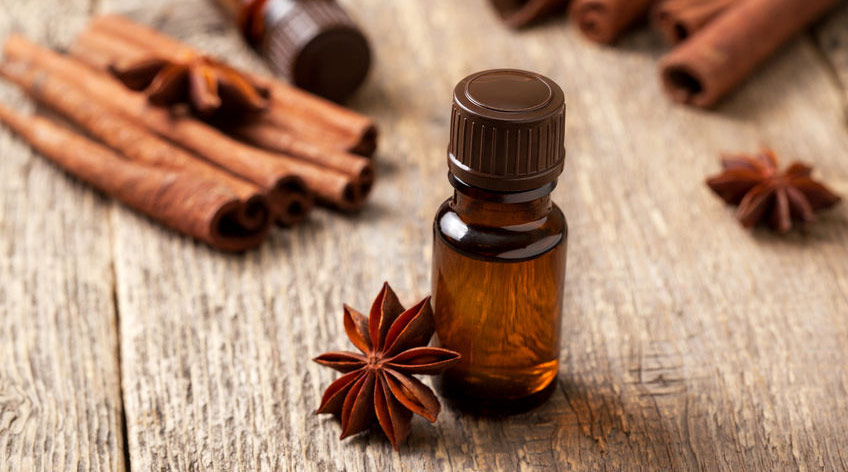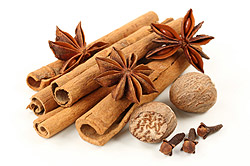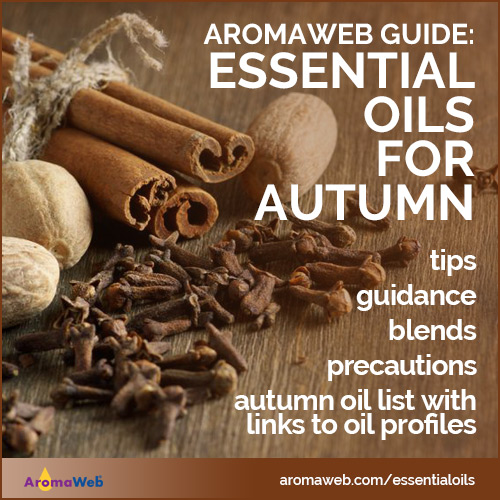Essential Oils for Autumn

As Autumn brings forth its cooler temperatures and richly colored falling leaves, it's a perfect time to enjoy diffusing and blending with warming essential oils like ginger, cardamom, cinnamon and clove.

Below is a list of essential oils well suited for incorporation into your favorite fall and autumn diffuser blends. The oils included in this list were selected for their warming, spicy, resinous or woody aroma. This is a highly subjective list. You may want to skim through the list of 110 oils contained in AromaWeb's Essential Oil Profiles area for oils that you personally like for Autumn.
By their nature, spicy essential oils like Cinnamon, Clove Bud and Ginger are strong and quite warming. A little goes a long way with these oils. They shouldn't be heavily diffused into a room as they can irritate the mucous membranes. It's best to blend stronger spice oils into more gentle oils like Sweet Orange Essential Oil (see the Blending Spice Oils section below).
A Warning About Applying Spice Oils to the Skin
My focus within this article is in selecting oils for diffusion. When creating blends and topical products that you apply to your skin, it is crucial that you understand that many of the spice oils are more prone to cause skin irritation and should be used as incredibly low dilutions, if used topically at all. For more information, read AromaWeb's Guide to Diluting Essential Oils and Essential Oils That May Cause Dermal Irritation and Skin Sensitization.
Essential Oils for Autumn (Fall)
Warming /Spicy / Resinous / Woody Essential Oils and Absolutes
- Allspice
- Anise
- Anise, Star
- Balsam, Peru
- Bay
- Bay Laurel
- Beeswax
- Benzoin
- Black Pepper
- Cardamom
- Carrot Seed
- Cassia
- Cedarwood, Atlas
- Cedarwood, Virginian
- Cinnamon
- Clove Bud
- Coffee
- Common Sage
- Coriander
- Cumin
- Dalmatian Sage
- Dill
- Fennel
- Frankincense
- Galbanum
- Ginger
- Gurjum Balsam
- Immortelle
- Myrrh
- Nutmeg
- Oakmoss
- Patchouli
- Rosemary
- Rosewood
- Sage, Clary
- Sage, Common
- Sage, Dalmatian
- Sage, Spanish
- Sandalwood
- Vanilla
- Vetiver
Blending Spice Oils
Spice essential oils can be quite strong. When I create a seasonal autumn essential oil diffuser blend, I typically start with a single essential oil that I particularly enjoy and then complement it by adding spice oils in low proportion.
Citrus oils, especially Sweet Orange Essential Oil blend well with the spice oils. Orange essential oil is especially abundant and is one of the most affordable of essential oils. It has few contraindications and most people love the aroma. During the chilly fall months, I love combining a few drops of ginger, cinnamon, clove, and/or patchouli with Sweet Orange, Mandarin or Tangerine. Working with the other citrus oils like Bergamot, Lemon, Lime and Grapefruit and the oils in the above list can lead to some lovely combinations.
Autumn Essential Oil Diffuser Blend Examples
Below are 3 example autumn diffuser blends. Create the blends by adding the proper amount of essential oils to a dark-colored glass bottle. Add the appropriate number of drops from your created blend to your diffuser following the manufacturer’s instructions.
Be sure and familiarize yourself using reputable sources for the safety and contraindications of all oils you choose to use. Make the smallest possible blend first to make sure you like the blend before doubling, tripling, etc. the recipe.
Please be responsible to find out the specific safety precautions and contraindications of the oils in the blends you choose to use.
Blend #1
- 10 drops Sweet Orange Essential Oil
- 4 drops Ginger Essential Oil
- 6 drops Patchouli Essential Oil
Blend #2
- 8 drops Sweet Orange Essential Oil
- 6 drops Lime Essential Oil
- 6 drops Sage Essential Oil
Blend #3
- 12 drops Sweet Orange Essential Oil
- 3 drops Cinnamon Essential Oil
- 3 drops Clove Bud Essential Oil
- 2 drops Nutmeg Essential Oil
Coniferous Essential Oils Are Also Nice in Fall Blends
Though more traditionally associated with Christmas and wintertime, I also like incorporating coniferous oils like Cypress, Fir Needle, Juniper Berry and Scotch Pine into my autumn blends.
General Safety Information
Do not take any oils internally and do not apply undiluted essential oils, absolutes, CO2s or other concentrated essences onto the skin without advanced essential oil knowledge or consultation from a qualified aromatherapy practitioner. For general dilution information, read AromaWeb's Guide to Diluting Essential Oils. If you are pregnant, epileptic, have liver damage, have cancer, or have any other medical problem, use oils only under the proper guidance of a qualified aromatherapy practitioner. Use extreme caution when using oils with children and be sure to first read the recommended dilution ratios for children. Consult a qualified aromatherapy practitioner before using oils with children, the elderly, if you have medical issues or are taking medications. Before using this or any essential oil, carefully read AromaWeb's Essential Oil Safety Information page. For in-depth information on oil safety issues, read Essential Oil Safety by Robert Tisserand and Rodney Young.
Shelf Life
Important Information About the Profiles
The essential oil information provided on AromaWeb is intended for basic educational purposes only. The references to safety information, test results, constituents and percentages is generalized information. Essential oils can vary greatly in composition. The data is not necessary complete and is not guaranteed to be accurate. The essential oil photos are intended to represent the typical and approximate color of each essential oil. However, essential oil composition and color can vary based on harvesting, distillation, age of the essential oil and other factors. Profiles for several CO2 Extracts and absolutes are included within the directory, and are denoted as such.
